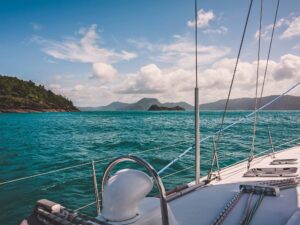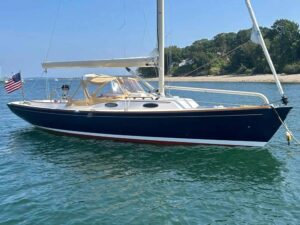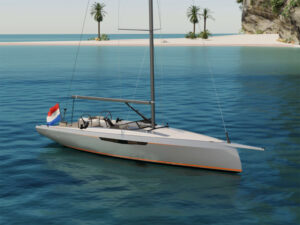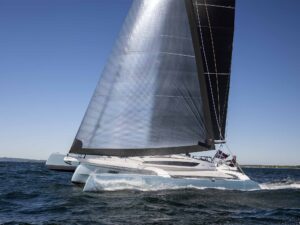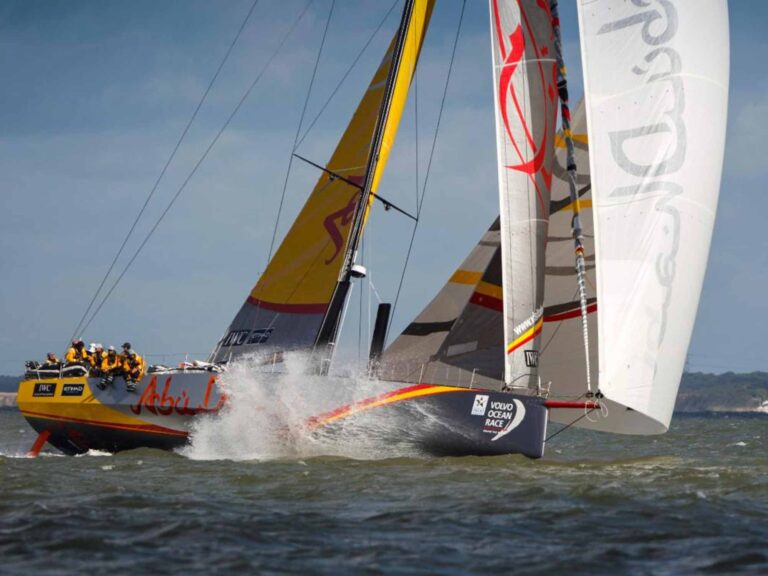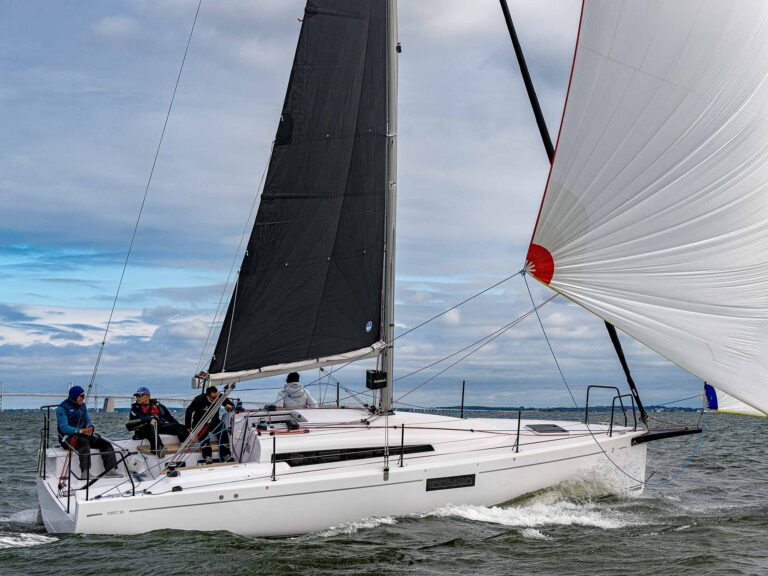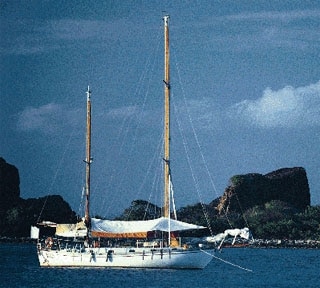
Makeover368
In 1979, when Terrie and I began building our 39-foot William Atkin-designed double-ended ketch, Nada, we started with a bare hull — no deck, no ballast, no interior, no nothing; just a big, plastic outdoor bathtub! By launch time in 1982, all the systems were in place and functioning — not that there were that many; we adhered to the Keep It Simple Stupid (KISS) cruising principle of the early 1980s. Our electrical system consisted of a single 8D battery (200 amp-hours), charged by a standard engine-mounted alternator (nominal 55-amp output) with a typical automotive voltage regulator. This provided electricity for a modest complement of fluorescent lights, a couple of fans, navigation lights, and a VHF and Loran. We had no refrigeration, just a well-insulated icebox. We converted our galley stove, initially diesel-powered, to kerosene.
Seduced By Luxury
Our systems worked well (excepting minor glitches, of course) throughout an extended cruise down the chain of the West Indies to Venezuela and back, but as I became more successful as a writer, we could afford and began to hanker after some of those gadgets and gilhickies we frequently encountered on more affluent boats.
We overhauled one system after another. Our first major upgrade was an engine-driven refrigeration unit, which we later replaced with a heavy-duty DC system. Life with both a fridge and a freezer is great! But more lights and fans, together with the DC refrigeration, necessitated a complete overhaul of the DC system. We doubled the size of our battery bank, installed a high-output alternator with a multi-step voltage regulator, and put in a sophisticated DC-monitoring device to track the DC systems status. We had to rewire all the primary battery and charging circuits to accommodate the much higher amperages flowing through the cables. Also, we added a 1,000-watt DC-to-AC inverter, allowing us to install a hot-water heater and microwave. An electric windlass retired our manual unit. We backed up our Loran, first with a SatNav, then a GPS, and we installed a shortwave receiver. The two-burner kerosene galley stove gave way to a three-burner propane unit with oven and grill — what a wonderful change that was! With a wind generator mounted on the boats stern, solar panels on the coachroof and a roller furler replacing our hanked-on headsails, Nada began to look like all the other boats we met in our travels!
Our upgrades resulted in a more comfortable, less arduous cruising life. Surprisingly, they created few maintenance problems, largely, I suspect, because Nada is very dry below, and because I took the trouble to use first-class materials and do each job right the first time around. However, there is no question that Nada could have functioned fine and continued to travel far without all this expense and effort, and we had done perfectly well before we had all these systems. Our cruising philosophy had changed, and our boat changed along with it.
Crunch Time
By 1995 at least 30,000 miles had passed under Nada’s keel. The detailed surveys for cruising guides on which we worked had required us to run the engine an unusually long 5,000 hours. The core equipment — rig, sails, winches, and so on — had suffered 15 years of reasonably hard use. Most of the add-on equipment was over 10 years old. As someone who makes a living writing about preventive maintenance, I had to take a long, hard look at my own boat. Although we suffered no rash of breakdowns, I knew it was time to either sell the boat or engage in a massive refit. At first we opted to sell, but we subsequently withdrew Nada from the market and decided we’d rather redo her major systems.
This refit will end up costing us around $40,000, an astounding figure considering that, when we briefly put Nada on the market, wed honestly advertised that the boat was a harmoniously functioning unit with every piece of equipment and system well maintained and performing more or less flawlessly. So how can we run up a $40,000 refit bill?
Despite functioning well, by 1995 our equipment was becoming rather old by marine standards. And herein lies the rub: The marine environment is so harsh that it naturally foreshortens the life of most systems and equipment irrespective of conscientious maintenance. There comes a point at which you have to wonder when the first run of major failures will start. If you intend to do serious offshore cruising, as we do, and you are conservative, you simply cannot afford to wait for complete failure. You have to bite the bullet and begin to rip out and replace what have been, until then, serviceable systems and hardware.
You can view an older boat as a worthwhile platform on which to launch your dreams of extended cruising economically. Indeed, for many people an old boat is the only way to get started. But you need to approach such a vessel in a pretty hard-bitten and cynical fashion because in even the best maintained and most pristine looking 10- to 15-year-old boat may lurk a headache. Refit bills can rapidly escalate.
For long-distance cruisers, preventive maintenance and proactive gear replacement are the order of the day. If, on the other hand, you intend to limit your sailing to coastal waters close to services and other resources, you can afford to push much of the existing equipment a little longer, with dramatic short-term savings in expenditures. Nevertheless, whether purchasing or owning an older boat, you should always keep potential upgrades and repairs in the back of your mind, for they may be only a short step away.
Had you been interested in Nada when we put her up for sale, you would have first concerned yourself with the basic structural integrity of the hull and deck. If structural integrity is at all in question, you should walk away from any deal. In addition, youd want to check hatches and ports, lifelines and stanchions, the plumbing, including tanks and seacocks, and the rudder, keel, and spars which, on Nada, all were in fine shape. Yet when we withdrew Nada from the market, we still wanted to upgrade or renew a number of systems onboard, and we chose to do it in one go. (For more on how to inspect an older boat, see “What a Pro Looks for in a Boat Survey” by Henry Mustin)
Replacing Rig And Sails
Our standing rigging was one of our major concerns, although it was all first-class with Castlok terminals. None of it showed any sign of problems. Never had any of it failed. Nevertheless, the rig was 15 years old, and had 30,000 miles on it. How many more fatigue cycles would the stays and shrouds go through before one failed without warning, imperiling the mast? Maybe the rigging was in good enough condition to go around the world. Then again, maybe not.
I know of no feasible way to test for these things, but I didnt want to be the one to discover that the rigging was approaching the limits of its lifespan, so we replaced it. This cost us something over $4,000, excluding labor, and took a couple of days worth of handyman-type work to cut the new stays and shrouds to length and to fit Norseman terminals.
We also considered our chainplates. For the past two or three decades, chainplates have invariably been fashioned from stainless steel and fastened with stainless steel bolts. Over time, moisture almost always penetrates the deck seals. If a section of the chainplate, or a fastener, resides in a permanently damp environment, hidden crevice corrosion of the stainless steel will ensue, which may or may not be evidenced by rust stains. Eventually, the crevice corrosion will lead to a sudden, potentially catastrophic rig failure. My prescription — a bitter pill to swallow — was to pull the chainplates and fasteners. On any older boat, you should at least pull a couple at random to see how they are wearing. Although replacement parts are unlikely to prove costly, labor can be extensive, depending on the installation. On Nada, we discovered a number of cases of incipient corrosion. Although none threatened the rig, our parts were fashioned from high-grade 316 stainless steel, as opposed to the more common 304. Had they been 304, I believe the corrosion would have been considerably more advanced.
Weve always been careful to cover or bag our sails after use, but even so, the working sails have now experienced the equivalent of several years continuous exposure to tropical sunlight. UV degradation must be taking its toll on the Dacron sailcloth. Although our Hood sails are well made and have never needed more than the most minor repairs, and although they still set well, I have to wonder to what extent the fabric and stitching has lost strength, and when the first seams will blow out. Anyone buying an older boat will be faced with the same significant question, no matter what condition the sails appear to be in, especially if the boat has seen a fair amount of use, and particularly in tropical waters. If previous owners have been less than diligent about using sail covers, or bagging the sails, then theres a good possibility the sails are just about done for. We need to replace our sails sooner rather than later. When we do, that will cost another $7,000 to $10,000.
An Aging Engine
In 1995 our Sabb 2JZ was running great. Aside from blowing a head gasket in the midst of a coral maze inside Glover’s Reef, Belize, our exceedingly heavily built, relatively slow-turning, raw-water-cooled marine diesel had never given us a moment’s trouble. From day one I had changed its oil and filters religiously, and ensured that it was fed clean fuel. Although it had logged 5,000 hours, there was no reason to think it wouldn’t run for another 5,000. Or was there? In fact, it began taking longer to crank on cool mornings, and it ran a little hotter than when new. Clearly, as you would expect from an engine with this many hours on it, it had lost some compression. In addition, I suspected some corrosion in the cooling system.
I had known for a couple of years that at some point I was going to have to engage in a substantial overhaul. However, I had been deterred from opening the engine up by the difficulty of obtaining and the horrendous cost of spares, and by a lack of time to do a full overhaul if it proved necessary. My biggest nagging fear was about the raw-water cooling system. This Norwegian-built engine was designed for cold, North Sea waters. Fifteen years in warm, tropical waters might have corroded the block and cylinder liners to the point at which the engine was essentially shot, in which case opening it up was likely to hasten its demise.
In the end, spurred by the need for more power for some of our surveying work, I simply replaced the Sabb with a Yanmar 4JH2HE. This necessitated replacing the exhaust system, the stern tube, the propshaft, and the propeller (the Sabb had an attached variable-pitch propeller). Also, I had to rebuild the engine beds. In spite of doing all the work myself with a helper, which took two weeks, I still spent $14,000. A yard bill for the complete job would probably have been in excess of $20,000.
My experience is not atypical. It is a sad fact that few auxiliary engines in sailboats are in good shape after 10 or 15 years. No matter how good it may look and how few hours it has on it, if it has not been properly operated and fastidiously maintained, it may propel you only towards major repair bills. On the other hand, most engine replacements will not require a new shaft and prop and newer, more-powerful engines designed to replace common older models often are manufactured with identical “footprints” so that you wont have to build new engine beds.
When purchasing an older boat, mechanical problems-in-the-making may be detected by a mechanically-inclined surveyor, but all too often surveyors limit themselves to little more than checking that the machinery runs without any obvious signs of distress. In many ways, it is better to buy a boat in which the engine is clearly a wreck, because then at least the boats purchase price will be commensurably depressed and you will know up front what you have to spend to repower.
The Offshore DC System
Whether intentionally or not, the DC system on an offshore boat mirrors the cruising philosophy of its owner. Those from the KISS brigade are likely to have little more than one or two batteries, the original engine-driven alternator, and an uncomplicated wiring harness powering a few lights and fans. On many days, I envy the simplicity of this approach. Those of us who have been seduced by the decadent 90s are going to lust after our fridges and freezers, inverters and microwaves, and electric windlasses and sail-handling devices, together with the large battery banks, high-output alternators, fancy voltage regulators, and sophisticated DC monitoring devices necessary to make it all work. The wiring harnesses for such systems will be as thick as your forearm, and woe to any new owner if all this hasn’t been properly installed using first-class components, and with thorough documentation and labelling of every cable and terminal!
Nothing had been wrong with Nadas original, 1980 harness, except that Id used what were readily available materials — mostly household wiring and automotive terminals — without any regard to boatbuilding standards, such as those legally required by the Coast Guard or the voluntary standards developed by the American Boat and Yacht Council (ABYC). Our system was very typical for an older boat, most of which could do with rewiring to bring them up to 1990s standards, particularly if continuous additions and alterations have been made to the electrical system, and especially if the owner made them! If the boat has a simple electrical system, any rewiring will be straightforward and relatively economical, which can be handled by a talented handyman prepared to study a manual or two (such as my Boatowners Mechanical and Electrical Manual, and Charlie Wings Boatowners Illustrated Handbook of Wiring). However, if a complex DC system needs replacing or upgrading, or if a simple electrical system is to be transformed into a complex one, just the necessary rewiring will be quite time-consuming and expensive, especially if it is contracted out to a marine electrician. And this does not include the cost of any equipment.
By 1995, multi-stranded, tinned cable, marine-quality terminals, adhesive-lined heat-shrink tubing, and a multitude of other products had become widely available for wiring boats. I also had become thoroughly familiar with the various standards that apply to electrical systems on boats. I felt it was no longer acceptable that I should write about these subjects while my own boat was not “up to code.” Hence, I rewired at considerable expense, including a couple of weeks of skilled labor.
When it comes to the equipment, a quick look at a couple of marine catalogs will show that a good-sized battery bank can run $1,000, a high-output alternator with a multi-step regulator and a DC monitor well over $1,000, a wind generator around $1,000, a couple of solar panels over $500, an inverter another $1,000 (plus the cost of the microwave it will primarily power), an electric windlass $2,000-$3,000 (with another $300 just for the high-current cables necessary to feed it), and so on. Add installation charges and its not hard to drop $10,000 into a DC system if you absolutely have to have all the creature comforts and toys and gadgets!
Its tough to determine the state of the DC system on an electrically-loaded older boat, especially if all the systems appear to work fine. The circuits and equipment may be properly installed with a pretty fair life-expectancy, but then again they may give rise to some seriously inconvenient failures early into a cruise, leading to expensive repair bills in out-of-the-way places. Unfortunately, many marine surveyors give only a rudimentary evaluation of electrical systems. If the DC system represents a significant part of the proposed value of a boat, it might be worthwhile to hire as well a competent marine electrical surveyor to give the system a thorough scrutiny.
The Rest Of The Story
The rig, engine, and electrical systems were the big-ticket core systems that we had to deal with on our cruising boat, but anyone sailing or considering an older boat must consider numerous additional important matters, including deck gear, plumbing, safety, and many smaller items.
The running rigging, along with its associated blocks, winches and hardware, also will likely have many miles on them. Everything needs careful inspection. Bear in mind that modern synthetic lines and deck hardware do not come cheaply, although some sailors can root out sources for first-class but very affordable, used equipment.
And then theres the ground tackle. If you are lucky, the boat will have been owned previously by someone who puts a high premium on plenty of anchors and rodes, as we do. If not, and you intend to head offshore, you can easily spend $1,000 to upgrade.
High on the list of amenities now demanded by most cruisers is refrigeration. Some systems are put in correctly and work like clockwork for 20 years with never a hiccup. Others are a constant source of problems and expense. If renewal seems a likely proposition, the most economical way to go is with the ever popular Adler Barbour Cold Machine or one of its clones, which you can buy for less than $1,000. However, these have very definite limits when cruising, particularly in warm climates. Next, in terms of expense, you can choose between several engine-driven systems, ranging in price from $2,500 to $4,000. Finally, heavy-duty DC systems are, for a number of reasons, your optimum choice for cruising, but they cost from $3,000 on up, not including the DC system necessary to support them! (See our test of refrigeration systems in the June 1995 issue — The Cold Facts, by Joe Minick)
The Cold Machine type of unit is pre-charged, sealed, and can be owner-installed in about a day using basic handyman skills. Because of EPA regulations concerning the handling of refrigerants, the other types of systems will require a refrigeration technician, at least for the hook-up and refrigerant charging process, probably at a cost of $60 an hour. Installation costs on higher capacity and more complex systems can run as high as their purchase prices.
This still leaves the icebox to consider. If you want to keep the energy demands of the refrigeration system within acceptable bounds, the icebox must be well insulated and closed with a well-sealed lid or door. All too many, especially on older boats, require a considerable amount of work, and to upgrade the box you may even have to rip out the old one and start again.
After refrigeration, maybe even ahead of it, I would put a propane galley stove and oven high on my list of equipment that turns a boat into a home. Unfortunately, many older boats have alcohol or kerosene stoves. Some manufacturers offer economical conversion kits, but any conversion to propane is another substantial project. To make a safe installation and house the bottles, you must find or make a locker that is appropriately sealed from the boats interior, vented overboard, and that holds the bottles securely. This is likely to take a couple of days crawling around in awkward spaces, cutting plywood panels, glassing them in place, and so on. The total cost of a completely new system, including a stove with oven, bottles and accessories but excluding labor, can easily be in the order of $1,500.
Then there are the pumps. Before heading offshore, you should replace the pressure water pump if it is more than a few years old. Any saltwater wash-down pumps and shower sump pumps probably will need the same treatment. You should rebuild the toilet and replace the diaphragms and valves in all manual pumps.
Every other piece of mechanical and electrical equipment needs close scrutiny, even down to the ballasts in fluorescent lights. At the least, if the task list looks too intimidating, carry spares for all these items so that you can replace or rebuild them along the way.
And what about the dinghy? If it is an inflatable and more than a few years old, its days are numbered. Thats another $1,000-$2,000, with as much again if the outboard needs replacement.
Finally, you can spend as little as a couple of hundred dollars for some updated flares and small fire extinguishers, or many thousands on safety gear if you include large extinguishers, harnesses, man overboard equipment, a 406 mHz Epirb, ditch kit and a life raft.
When all this is done, you may decide that the boat needs sprucing up with a new full set of cushions ($1,000-$2,000), a dodger and/or bimini ($500 on up), and an Awlgrip paint job at a cost with labor (for the hull and deck combined) of $250 or more per foot!
Keeping Things In Perspective
So you see, it is not difficult to drop $40,000 or more into an older boat, even one that is in basically good condition! Suddenly, your $60,000 bargain has become more like a $100,000 cruiser, even without the latest electronics for the navigation station, and this assumes that you’ve done much of the work yourself and do not account for your sweat equity!
Despite the seemingly high expense, the upgraded boat likely will cost not much more than half a comparably-equipped new boat. If you are careful to select an older cruising boat whose design and desirability have stood the test of time, your money will be well spent. If you select a boat design/model that is not popular, or is somewhat obscure, you may not be able to recoup your investment when you resell. Keep in mind that even a new boat is likely to need additional gear to make it ready for cruising. With scrutiny and the help of a good broker and surveyor, you may even find an older vessel with previous quality repairs, upgrades and care. In either case, an old boat can be a bargain — except, perhaps, when you come to sell it and find its value is depressed by all those cheaper, less well-appointed sisterships on the market. You will have to measure the return on your labor and investment by the years of pleasurable cruising that you get from your boat, rather than the price it fetches upon resale. In our case, Nada is just about ready for another 10 years of hard use.
Of course, not all upgrading is absolutely necessary. Someone could have bought Nada in 1995 and probably used her for a number of years without investing a single penny in new equipment, and without experiencing a major breakdown. Once again, I need to stress that we presumed that our boat would undertake serious offshore work and long-distance cruising to out-of-the-way destinations, which warranted a proactive approach towards replacing older systems and gear. Furthermore, a good part of our $40,000 upgrade was tied to our desire for a cruising life that includes ice in our cocktails and the ability to whip up a baked potato in the microwave. With scaled-down expectations, your up-front maintenance and replacement costs can be proportionately reduced. Remember, also, that the volume of the boat and the cost of new systems tends to increase rapidly, and disproportionally — a 40 footer and its gear and appropriate systems are actually nearly twice as large and costly as a 30 footer.
A well-found older boat can be an excellent starting point, and often the only possible starting point, for turning cruising dreams into reality. The core systems that are critical to safety will need a close scrutiny and, likely, some significant investment of time and money. Beyond these, most of us need very little in the way of luxuries to have fun.
Terrie and I have wonderful memories of our first extended cruise, which we made on a very simple boat. Now that we can afford greater luxuries, and we have a growing family, we will not return to that spartan style of cruising. But if we could not afford the luxuries, we wouldnt delay a long-dreamed-of cruise by a single day just to become able to purchase some fancy new piece of gear that was not necessary for the basic functioning of the boat. Altogether too many boats remain tied to the dock while their owners keep pouring money and equipment into them. At some point, if you are to get anything back out of your boat, you simply have to say, “Enough is enough; its time to go sailing.”
————————————————————————
For 20 years Nigel Calder has transformed Nada, a 39-foot Atkins-designed Ingrid, from a bare hull to a tricked out voyaging machine, but it has taken more than a few hours and a couple of bucks. Nigel Calder is profiled by John Kettlewell in “Meet The Guru Of Sailing Systems.”

